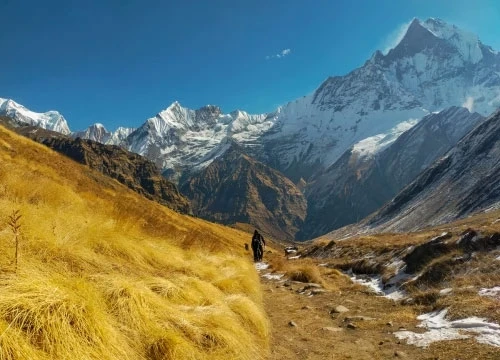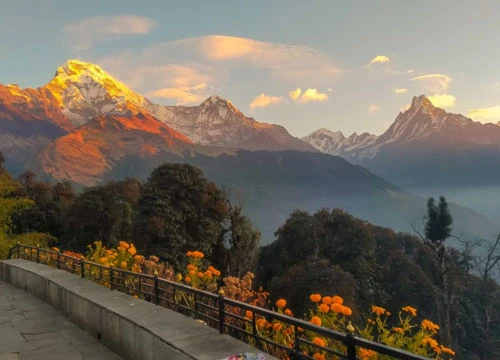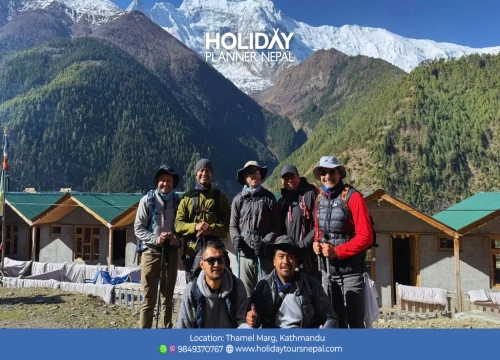Required Permits
Climate and weather around Mardi Himal
The best time for visiting or starting activities for the Mardi Himal is during the spring and autumn season.
During spring and autumn in Nepal, clear skies enhance the visual experience by offering breathtaking vistas. During this particular season, the awe-inspiring mountains and landscapes, which are noticeable through the unobstructed sky, propose a profound sense of wonder. As the altitude increases, temperature variations may range from 15 to -3 degrees Celsius (59°F to 26.6°F). In contrast to spring and fall, the summer and monsoon seasons exhibit higher precipitation levels and increased slipperiness.
The number of trekkers is reduced throughout both winter and monsoon due to the presence of chilly winds and clear skies. Natural disasters like floods and landslides can be influenced by weather conditions, especially during monsoons. Therefore, the potential dangers associated with severe weather conditions might contribute to the successful completion of the trek within the designated timeframe. Furthermore, favorable climatic conditions of spring and autumn contribute to an improved outlook and facilitate our cognitive and emotional reestablishment of a bond with the natural environment.
Therefore, spring and autumn are the best seasons according to the weather patterns and temperature fluctuations, the change in the temperature is influenced by changes in elevation.
Local culture and religion around Mardi Himal trekking trail
Visitors get the opportunity to gain further insights into the local customs and civilizations. This region exhibits a diverse array of ethnic groups residing within its boundaries. The observation of individuals engaged in bamboo craftsmanship, ghee production, food preservation, plant cultivation, and the exploration of diverse cultural practices was made possible.
The region covers a diverse range of ethnic communities, including the Brahmins, Chhetri, Gurung, Magar, and various other tribes. There exists a diverse collection of ethnic groups, which can be generally classified into the Mongolian and Aryan tribes, in summary. The primary cause impacting the selection of this particular area is the presence of a diverse and vibrant cultural environment, characterized by a crowd of customs and practices that exhibit variations based on caste distinctions. The influence of harmony in ethnicity on individuals living around the regions is widely seen.
How to prepare for Mardi Himal trek?
Preparing physically for higher heights can provide challenges, particularly for individuals coming outside of the Himalayas. Indeed, Nepal holds the distinction of being the nation situated at the highest elevation on Earth. Fortunately, the Mardi Himal Walk is characterized by a more modest duration and altitude, rendering it shorter in comparison to many alternative trekking routes available in Nepal. Preparing for the Mardi Himal Trek does not provide significant challenges.
It is recommended to start preparing three to six months before the beginning of your Mardi Himal journey, walking around 1-2 hours per day for five days. After approximately three weeks, one will acquire the ability, a fitting moment arises to enhance one's capabilities. Engage in the regular practice of carrying a bag weighing between 10 to 15 kilograms, at a dedicated time slot of three hours per week for an extended climbing activity. If, by chance, this particular lifestyle departs from your own, you will promptly encounter the advantages of this gentle physical activity.
Is travel Insurance required for trekking in Mardi Himal?
Holiday Tours Nepal strongly recommends all our clients to obtain travel and medical insurance to protect themselves from unforeseen circumstances that may arise during the trek. Before embarking on a journey to destinations inside the Himalayas, it is important to obtain both travel and medical insurance.
Beginning any journey or high-altitude trek in Nepal requires safety and precautions, Holiday Tours Nepal recommends all its customers acquire the necessary travel and medical insurance as required by law. The policy should provide enough protection for individuals engaging in treks and tours, surrounding a complete range of coverage for physical injuries, fatalities, medical expenses, and deportation costs associated with emergency evacuations.
This coverage should extend to various modes of transportation, including but not limited to helicopter rescue, air ambulance services, and protection for personal belongings.
Note: Travel Insurance is not mandatory but incase if things goes sideways having something is better than having nothing.
Can we get mountain sickness during Trek?
Altitude Sickness can affect any individual at any time during the time of walk. The reduced availability of oxygen at elevated altitudes poses respiration difficulties. It usually occurs at an altitude above 2500 meters (8,200 feet).
The symptoms of altitude mountain sickness are as follows
- The individual is experiencing symptoms of headache and dizziness.
- The symptoms of nausea and vomiting.
- The topic of discussion pertains to the state of tiredness or fatigue.
- Experiencing fatigue yet unable to attain restful sleep.
- Loss of appetite.
- The emotional states of anger and tension.
To minimize the risk of Acute Mountain Sickness (AMS), individuals should adopt suitable clothing according to the temperature, maintain proper hydration by consuming good amounts of water, follow a nutritious diet, and engage in physical activities. In the event of physical discomfort, it is advisable to seek rest and engage in relaxation techniques. It is recommended to maintain proper hydration wake up early in the morning and have some deep long breaths.
Please do not hesitate to request a break from the leader or guide if you are experiencing any physical discomfort. Occasionally, individuals may observe their dizziness as unimportant; yet, even a seemingly little appearance of this condition could potentially facilitate the unintentional access of water into the brain or lungs which may result in High-altitude cerebral edema (HACE) or High-altitude pulmonary edema (HAPE).
Hotels and Accommodation facilities
Each of our walks, treks, and tour itineraries involves lodgings in suitable establishments such as hotels, lodges, homestays, guest houses, and resorts. Camping in certain remote areas is conducted by a prearranged itinerary. The duration of various trails can vary depending on factors such as the fitness level and pace of customers, the occurrence of airplane cancellations, adverse weather conditions, and the condition of roads or trails.
In the context of residing in an economically disadvantaged country, it is frequently necessary for us to compromise on the quality of services available. This is because as we progress towards higher elevations in mountainous areas, there is a decrease in both the abundance of vegetation and the density of the local people.
Nevertheless, due to its status as a popular tourist route, the majority of facilities remain available, although with potential adjustments. Examples of amenities commonly found in various accommodations include access to the internet, availability of hot showers, provision of toilet commodes, availability of laundry services (owing to limited warmth and sunlight), uninterrupted 24-hour power supply, and the quality and availability of rooms (typically designed to meet necessities). Nevertheless, the crew at Holiday Tours Nepal struggles conscientiously to provide excellent facilities and services.
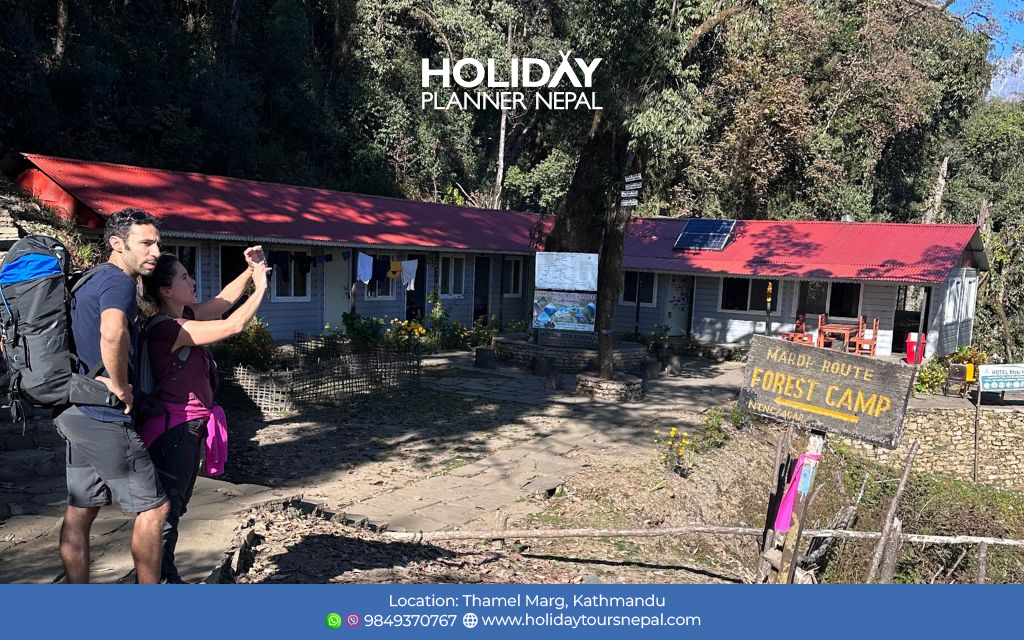
How to acclimatize for the trek?
The ability to adapt to various environmental circumstances, such as weather conditions, local traditions, cultural practices, and food offerings, is crucial for completing and originating satisfaction from the walking experience. When planning routes, it is important to follow the guideline of not ascending more than 1000 meters in a single day. The ability to go beyond 1000 meters in a single day is not allowed and is not considered healthy; however, such an attempt may lead to respiratory challenges and the onset of altitude sickness.
Nevertheless, by accepting a slow and measured approach, it may be conditional that we are facilitating our physiological adjustment to the ambient temperature, atmospheric conditions, and overall climatic conditions.
How to make the Mardi Himal Base Camp trekking more fun and memorable?
Inquiring about the indigenous population, their societal practices, customary norms, and cultural heritage serves as a means to get further knowledge about the traditional and cultural aspects of the destination we are journeying to. The purpose of our effort does not involve continuous ambulation, and the presence of a guide does not necessarily denote a classified dynamic where one merely trails behind.
In certain occasions, reaching a compromise on dietary choices may prove impossible, as such concessions might bring physiological and psychological strain, leading to symptoms such as headaches, gastrointestinal disturbances, and heightened irritability. Additionally, this predicament may engender a perception of inadequate provisions and a feeling of mistreatment.
Note:It is advisable for travelers to consistently disclose any food allergies or dietary restrictions when inquiring about hotel options and before embarking on a tour. This practice facilitates the development of alternative options for meals and beverages.
Is hot water available and how is the toilet facility at Mardi Himal?
Due to the scarcity of both natural and man-made amenities in the Mardi region, there is a necessity to improve the quality of services. Certain geographical areas experience limited availability of hot showers due to a scarcity of gas and wood resources at high camp. Consequently, hotels in these regions charge additional costs for hot water and showers. Hotels use LP gas or wood for warming hot water and bathing purposes. Lack of transportation makes mineral waters expensive. Hotels use a portable water filtration system for water purification.
Note: Water-purification tablets are a good alternative for budget trekkers rather than buying expensive mineral water bottles.
Lodges, hotels, and tea shops in the Mardi region are equipped with squat toilets and western toilets. Old hotels have squat toilets that require individuals to sit in a squat position to eliminate the body waste. This design commode is mostly used due to limited availability of water resources. Modern Western toilets require a minimum of 1 to 3 liters of water for each flush, a demand that surpasses the available water supply.
Note: Western commodities are available in certain hotels. Due to this facility, the hotels are packed and require prior booking.
Internet and Electricity
In Low camp, High camp, and Bandal Danda, there is absence of electrical amenities and internet. Furthermore, even in locations where such facilities exist, the occurrence of load shedding can lead to an artificial or natural shortage of energy. To replenish the energy reserves of smartphones, cameras, flashlights, and other electronic devices, it is recommended to possess a portable power bank. Hotels and tea houses charge additional fee for battery recharge as the power must be utilized from other sources. Examples solar energy, generator, and local hydropower systems.
The cost of internet access varies across different regions, and its availability is not universal due to factors such as infrastructure requirements, including power supply and private poles, as well as the significant financial investments required by local communities for the installation of poles, cables, and internet service providers.
Tips for trekkers who are trekking in the Himalayas
Tips for female travelers during periods in the mountains
Know your cycle and pack accordingly sanitary pads, period underwear’s, menstrual cups and tampons.
Pack sanitary pads in case sometimes the dates can be up and down and even someone might need in trek in case you don’t use it.
Bring pain relivers like ibuprofen, heat patches, to ease cramps stay hydrated and eat good nutrition food.
- Wear comfortable and food layered clothing’s rest when needed and mind your mood.
Equipment and Gear List
 General
General
- Four-season (-20 degree) sleeping bag (We provide rental sleeping bags available for an additional USD 35)
- Puffy down jacket (We provide rental jackets for an additional USD 35)
- Daypack (25-30 liters recommended) with rain cover
 Upper Body
Upper Body
- Sun hat or cap (We'll provide you with a trekking cap.)
- Warm woolen hat
- Scarf/Neck Buff (highly recommended to get saved from wind and cold)
- Headlamp or mobile torch light for nighttime
- Polarized sunglasses
 Torso
Torso
- Technical fabric base layer thermals are light for warmer months, heavy for colder months
- Technical fabric t-shirts and sleeve sweaters or high-necks
- Waterproof rain jacket
- Windproof jacket for the walk as it gets windy
- Fleece jacket or down jacket
 Lower Body
Lower Body
- Thermals inner
- Hiking pants at least 3
- Comfortable pants for teahouses
- Waterproof, windproof shell
- Hiking shorts
 Hands
Hands
- Woolen gloves for the tea house
- Hard-shell windproof outer gloves for the walk
 Feet
Feet
- Marino Wool or comfortable, warm socks
- Hiking socks
- Liner socks
- Trekking/hiking boots (waterproof recommended)
- Crampons (For passes)
- Casual shoes or sandals that are comfortable for the time in the tea house
- Gaiters (lightweight for rain and snow)
 Undergarments and Inner Wears
Undergarments and Inner Wears
- Technical fabric/quick drying (can be washed during the trek)
- Sports bras (women)
- Sleeping clothes as per the comfortability
 First Aid Kits and Medications
First Aid Kits and Medications
Note: Our guides carry medications, oxygen cans, and first aid kits during the trip. However, personal kits and medications are recommended.)
- Sunscreen SPF- 50+
- Lip balm or Vaseline
- ointment cream
- Cough Syrup and strepsils (recommended for Khumbu Cough)
- Creams and medicines (for any allergies or diseases)
 Other Essentials
Other Essentials
- Passport
- Extra copies of passport-sized photos
- Reusable water bottle
- Toilet paper, small soap, and shampoo
- Water purification tablets or UV water purifier (if you plan to treat water)
- Water bladder for the day bag
- Small towel for personal use
- Pillowcase in case of allergies to new pillows
- High-protein snacks (such as mountain bars or nuts)
- Waterproof/dry bags for carrying essential documents, stuff, frequently used items, and money
- Power bank or extra batteries
- Cameras and mobile phone
- Cards/book
- Pee bottle/ pee funnel for women
- Trekking poles
- Whistle in case your voice is not loud enough to stop or start
- Thermos for hot water during the nighttime
- We give you a free duffel bag, trekking cap, maps, and t-shirt during your pre-trip meeting in Kathmandu. The duffel bag will be used to pack your trekking supplies.
- For every two participants, we assign one porter. The porter will carry the duffel bag, which should weigh around 10 kg/22 lbs., throughout the walk.
- Daypack bag for daily used stuff like cash, documents, papers, a water bottle or bladder, a camera, toiletries, sunscreen, a notebook, clothing, etc. (with a waterproof cover).
- You can store your luggage (on-trekking items) at the hotel in Kathmandu, and we can assist and help.
- Total luggage for the Kathmandu-Lukla flight is (15 kg/33 lbs.), including duffel (10 Kg/22 lbs.) and backpack (5 kg/11 lbs.)
- A down jacket with a hood(cap) to be warm in altitudes above 3,000m.
- We can provide a down jacket for USD 35. In case of loss or damage, you need to pay back the cost of USD 200 per item.
- We can provide a sleeping bag for USD 35. In case of loss or damage, USD 200 per item must be paid.
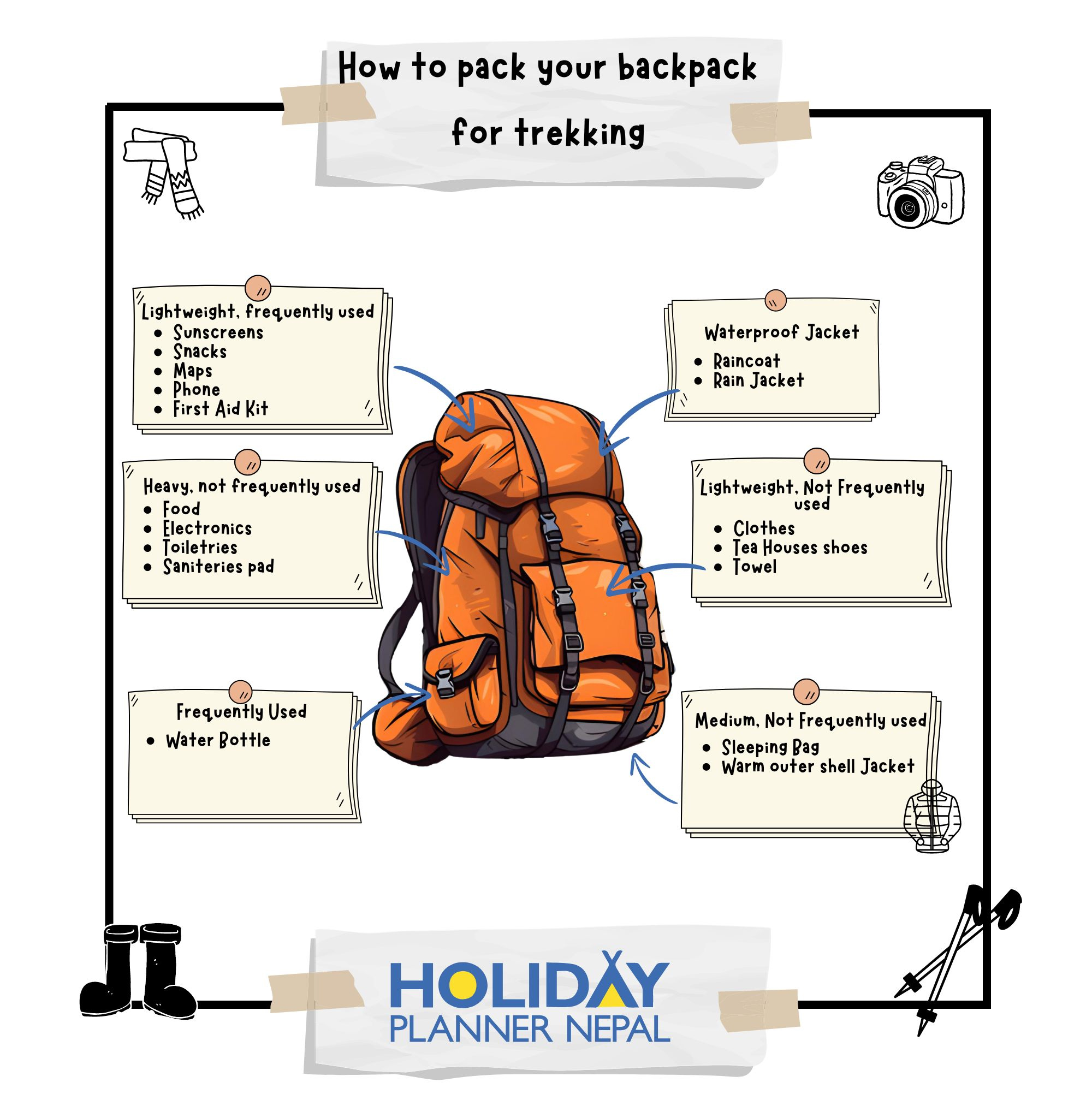
Note: Supplies and gear can be rented or purchased in Kathmandu. Once you are in Nepal, you can buy supplies and gear for hiking if you have spare time. Holiday Planner Nepal representatives will assist you in purchasing the equipment. Thamel a tourist hub, offers a wide range of trekking equipment at affordable prices. Don't wear short clothes inside the monasteries and religious places.
Why Holiday Tours Nepal for Mardi Himal trek?
Safety is of utmost importance to us. In terms of cost management for our hikes and treks, we strictly obey a policy of non-negotiation. Our trekking guides have been selected based on their technical expertise, proven safety record, sound decision-making abilities, friendly nature, and ability to provide valuable and informed guidance and service. Holiday Tours Nepal possesses a high level of skill in the use of first aid techniques and the utilization of personal protective equipment for ensuring safety. For trekking and climbing activites in the Annapurna Region, we provide the provision of first aid kits and supplies for all guided climbs and excursions.
Advantages of booking Mardi Himal Base Camp Trek with Holiday Tours Nepal.
- We provide private car transportation services for the collection and delivery of passengers to and from specified locations on both international and domestic flights.
- We provide first-aid kits and first-aid services.
- Holiday Tours Nepal provides a range of essential items for travelers, including sleeping bags, down coats, T-shirts, caps, duffel bags, and city and hiking route maps, as required.
- We organize rescue and evacuation services as well which have to be paid for by the client or the travel insurance of the client.
- We provide an oximeter to monitor one's pulse, oxygen saturation, and heart rate daily. This practice proves to be very valuable in assessing symptoms related to Altitude Mountain Sickness (AMS). This measure aids in ensuring that your voyage is entrusted to the most secure and reliable individuals.
- Holiday Tours Nepal offers SIM cards to all its guests, ensuring seamless connection throughout their journey in Nepal. The client is responsible for covering the costs associated with the data pack and the activation charge for the SIM card.
- Fresh and seasonal fruits are provided after dinner and cookies are provided at tea/coffee time.
Conclusion
Mardi Himal Trekking is a perfect blend of natural beauty, cultural richness, and Himalayan adventure. This short yet rewarding journey offers trekkers a peaceful alternative to the more crowded Annapurna region trekking routes. From lush rhododendron forests to panoramic views of Machhapuchhre and Annapurna peaks, every step along the Mardi Himal Base Camp trail is filled with breathtaking moments. Whether you are seeking a beginner-friendly hike or a scenic short trek in Nepal, Mardi Himal Base Camp Trekking promises an unforgettable mountain experience.
👉 Book your Mardi Himal Trekking adventure today with Holiday Tours Nepaland explore one of the most beautiful hidden gems of the Himalayas. Let our expert guides make your dream of trekking in Nepal a memorable reality!
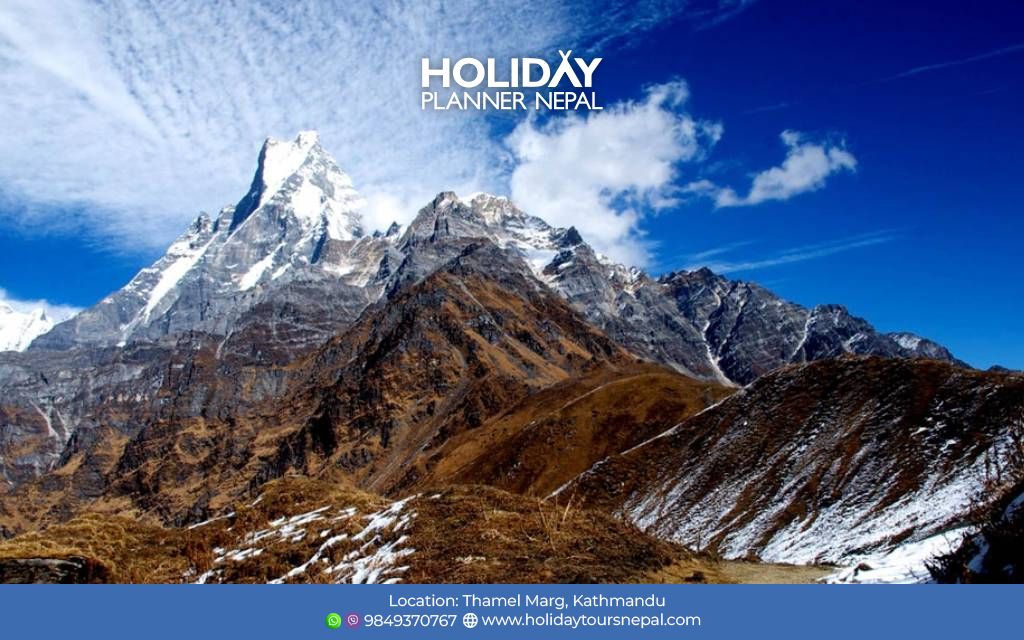
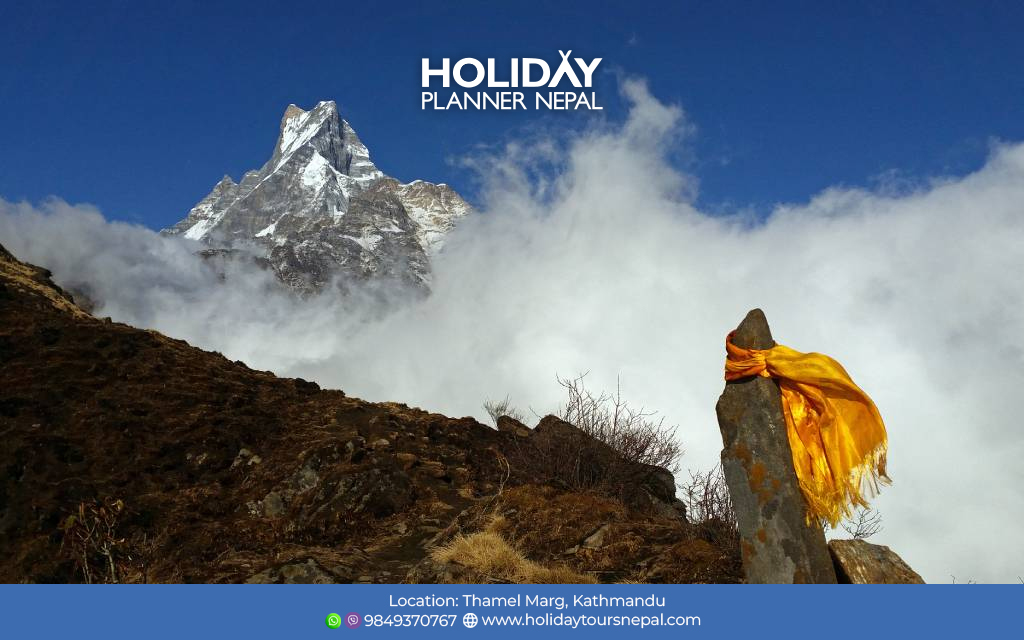

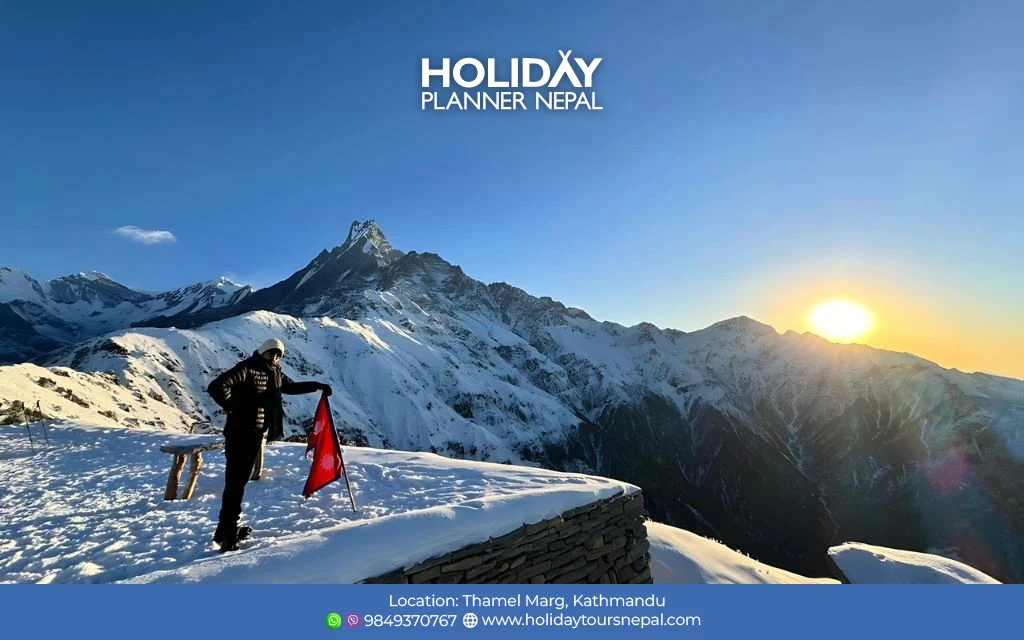
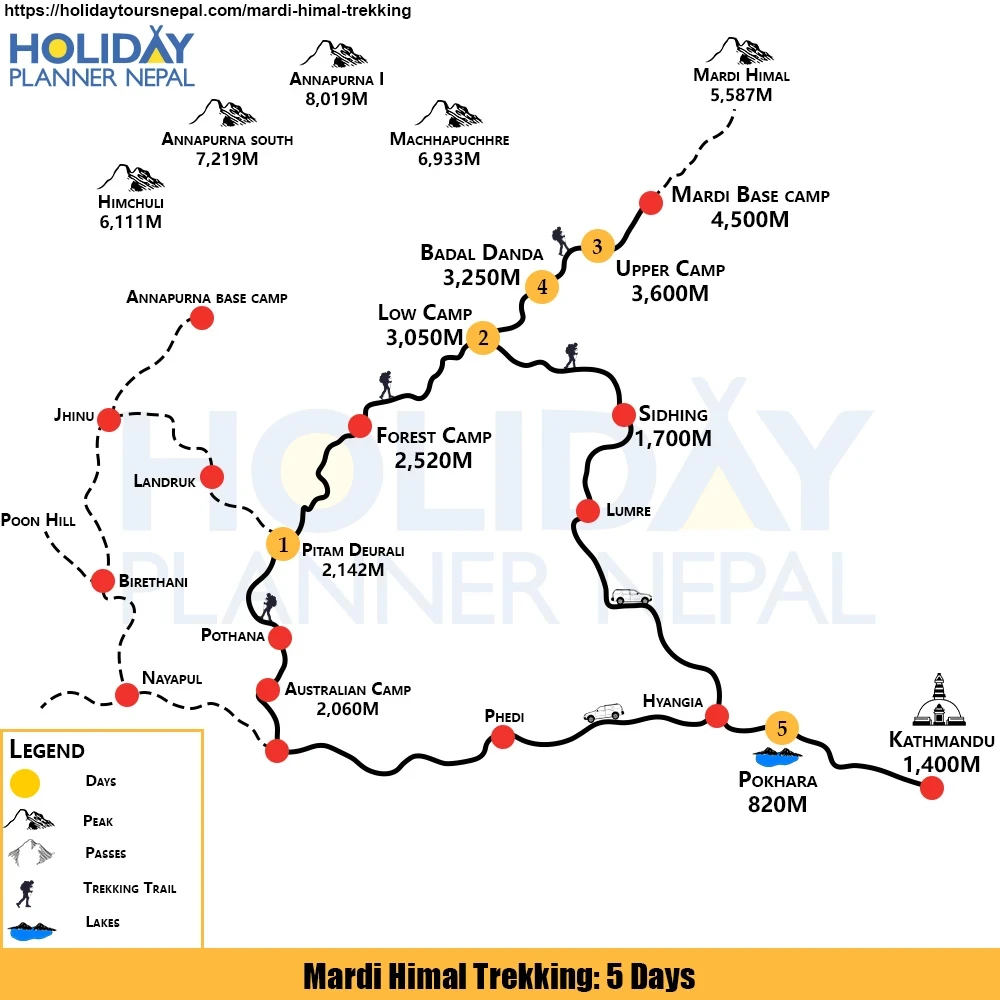

 General
General Upper Body
Upper Body Torso
Torso Lower Body
Lower Body Hands
Hands Feet
Feet Undergarments and Inner Wears
Undergarments and Inner Wears First Aid Kits and Medications
First Aid Kits and Medications Other Essentials
Other Essentials

